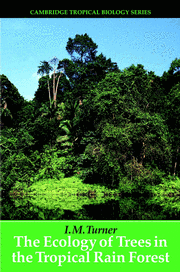3 - Tree performance
Published online by Cambridge University Press: 24 November 2009
Summary
Age, size and growth in tropical rain-forest trees
The growth rates of tropical trees are usually estimated by repeat measurements of dimensions, most often that of stem girth or diameter. If tropical trees could be aged easily and accurately then estimates of average growth rates would be possible from one-off measurements. The age of trees in the temperate zone can generally be estimated precisely from counting annual rings on cores taken from the trunk base. Tree rings are caused by periodic variation in the nature of the wood laid down at the cambium. Wood growth is often so uniform in tropical trees that rings are undetectable. Where they are present they may represent checks on normal growth that occurred at irregular intervals. However, there are certain tropical regions where dry seasons, or very wet ones with flooding, are strong enough annual signals to produce yearly rings (Martínez-Ramos & Alvarez-Buylla 1998).
Most tropical lowland forest trees do not have annual rings. Old trees can be aged by using 14C-dating techniques on wood samples from the heart of the trunk base. This method has recently been applied with some startling results on large trees from the Amazon basin (Chambers et al. 1998). Twenty large trees from near Manaus, Brazil, were found to have ages (± 80 years) of 200–1400 years. The oldest was an individual of Cariniana micrantha. There was a poor correlation between size and age, even within a species.
- Type
- Chapter
- Information
- The Ecology of Trees in the Tropical Rain Forest , pp. 103 - 121Publisher: Cambridge University PressPrint publication year: 2001



